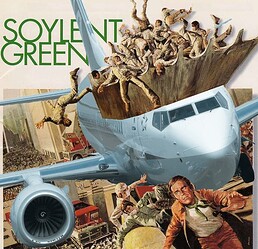Supposedly Hubbard’s 1952 book has a section on Piltdown. Bad timing, there. And successive editions have kept it.
I was listening to ABN, but I found a version of it here:
The conversation starts about 10 minutes in. They talk for about 3 minutes. The line is:
“…Now I’ve taken-up Dianetics. Only to straighten-out my friends, of course.”
I read everything Ayn Rand wrote because there was a whole section in the library on it and I had a lot of time on my hands so I skimmed through it to figure out why my nerd friends in college were into it. Never figured out a logical, objective reason for it, except that some proportion of nerds, like any demographic, grow up to be manipulative assholes who want to nuke the untermenschen. How else could this unendurable body of reaching polemic be liked and promoted by so many and with so much money. I was like, okay, not using the word “cult” exactly right now, but I’m just moving it over to the same column as Scientology, Christianity, Mormons, Nazism, and ESPN.
I think some people will champion any thin gruel of a worldview as long as it tells them “being a selfish asshole is good actually, even superior to those nerds who say you can’t just treat other people like shit”. It’s dispiriting.
I’ve also read most of her stuff and I think the just-a-little-light-rape view of sex appeals to the incel types. Anyone who finds themself to be “angular” would be pleased, it’s her top description of attractiveness, it felt like.
Thin gruel indeed.
That was for when airliners didn’t really break 10,000 feet, so turbocharging wasn’t needed but you could take half a turbo, the turbine, and gear it to the crank.
I always thought they could have gotten to the “high speed” aircraft piston engine by using both (one) sleeve valve that was the whole sleeve and a pent-roof 4-valve poppet system. I’m uncertain which would be the exhaust though. Probably the poppets with plenty of waterjacket room around the chamber. Lots of new techniques like a tall piston head and so on.
Then add turbocharging.
I’m no reciprocating engine scientist, but as I understand it…
-
Reciprocating engines pretty much have to drive a prop, while turbine engines can drive a prop and/or can use their exhaust for thrust.
-
Props with fewer longer blades tend to be more efficient.
-
In high-speed flight, if you go with a few long blades, they exceed the speed of sound, and lose a lot of power to drag, constant sonic booms, etc.
-
If you’re using props, they measure engine performance in hp or kw. I assume there’s a reason. Since KE = 1/2 MV^2, if power is more-or-less equal at different speeds, you get more thrust at lower speeds, less at high.
-
If you’re using jets, they measure engine performance in pounds or newtons. Usually for static thrust. I assume there’s a reason here too. Since KE = 1/2 MV^2, if thrust is more-or-less equal at different speeds, you get more power at high speeds, less at low.
-
I wouldn’t be surprised if different speeds cause more wear-and-tear on different types of engine, too.
No enforcement, and certainly not retroactive. And unethical people were taking part in crafting it.
It’s like having criminals making laws. Wait, I guess that’s true too . . .
Turbine engines running props only get very efficient with unobtanium-level materials and precision. The amount of waste heat they produce in 1940s trim can only be recouped by hooking them up to a steam engine. Not great for airplanes. The issue with piston engines is when they get big. Jets scale better than reciprocating square/cube-wise, which is what I was speculating about improving.
From
Schiaparelli’s shoe hat
By Ullstein Bild, 1937
I wonder if Terry Gilliam was influenced by this in his movie, Brazil, or did he come up with it independently?
A magician worms his way through German history.
I have never heard of this person, but now I know how the phrase “Sim Sala Bim” came to the United States.
I wonder what it will smell like in the passenger compartment . . . .
But it’s sustainable. Soylent jet fuel is made from people!





